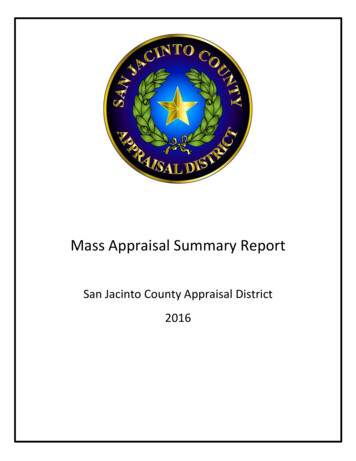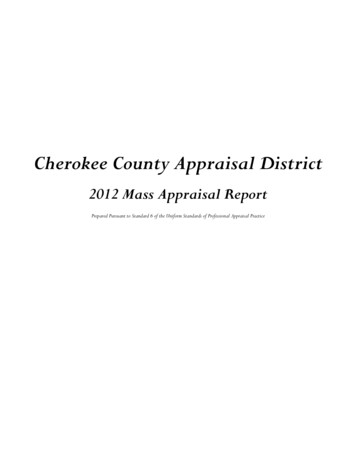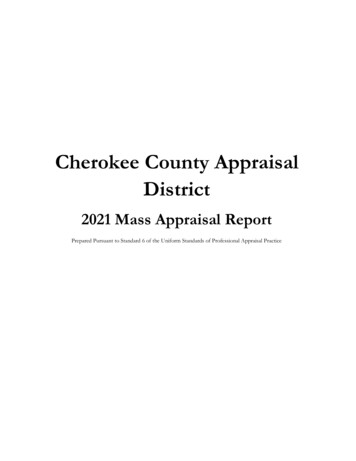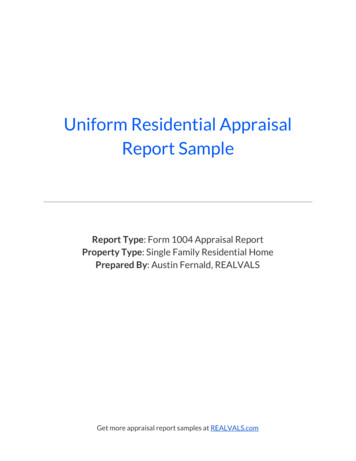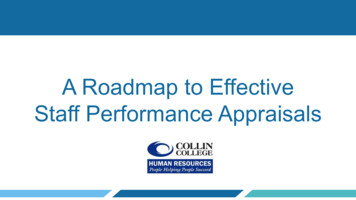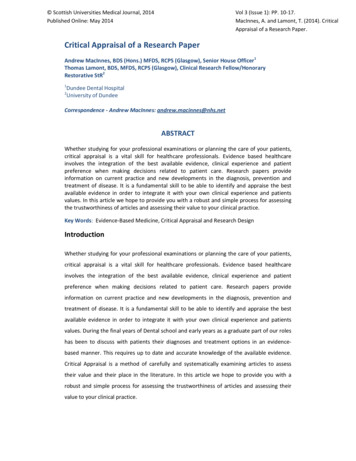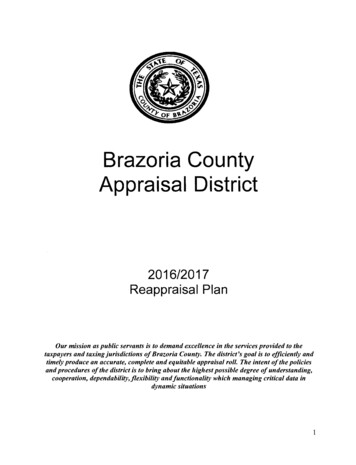
Transcription
Brazoria CountyAppraisal District2016/2017Reappraisal PlanOur mission as public servants is to demand excellence in the services provided to thetaxpayers and taxing jurisdictions of Brazoria County. The district's goal is to efficiently andtimely produce an accurate, complete and equitable appraisal roll. The intent ofthe policiesand procedures ofthe district is to bring about the highest possible degree of understanding,cooperation, dependabi/ity,jlexibi/ity andfunctionality which managing critical data indynamic situations1
RESOLUTION NO. 2016-2017A RESOLUTION OF THE BOARD OF DIRECTORS OF THE BRAZORIA COUNTYAPPRAISAL DISTRICT APPROVING AND ADOPTINGTHE 2016-2017 REAPPRAISAL PLANWHEREAS, the Texas Tax Code obligates the Board of Directors of the BrazoriaCounty Appraisal District to adopt a written plan for the periodic reappraisal of allproperties within the district's boundaries; andWHEREAS, Texas Tax Code, Section 6.05 expressly requires the Board of Directorsto complete all hearings, amendments, and resolutions necessary for the plan'sadoption no later than September 15th of each eligible year; andWHEREAS, the Board of Directors believes the adoption of the proposedreappraisal plan as submitted for years 2016-2017 is in the interest of the public;NOW THEREFORE, BE IT RESOLVED AS FOLLOWS:The Board of Directors of the Brazoria County Appraisal District hereby adopts theattached 2016-2017 reappraisal plan as submitted to be implemented by theBrazoria County Appraisal District.PASSED, APPROVED, AND ADOPTED this the 13th day of September 2016.ATTEST:ectorsBrazoria County Appraisal District2
TABLE OF CONTENTSPREAMBLE4THE BASICS/CONSTITUTIONAL STANDARDS7HOW DOES THE SYSTEM WORK?8EXECUTIVE SUMMARY10REQUIREMENTS/ASSUMPTIONS/LIMITING CONDITIONS10OVERVIEW12TAX CODE REQUIREMENT16RATIO STUDIES GUIDELINES20USE OF FORECLOSURES22PTAD RATIO STUDY22PLANNED ACTIVITIES23ANALYSIS, PLANNING AND ORGANIZATION25MASS APPRAISAL UPDATING SYSTEM27PLANNED REAPPRAISAL29REAL PROPERTY ESTIMATES34OTHER APPRAISAL TYPE OVERVIEW34EQUITABLE & UNIFORM ANALYSIS38VALUE DEFENSE OVERVIEW39MASS APPRAISAL REPORT REFERENCE40LIMITING CONDITIONS41MASS APPRAISAL FLOW CHART42BCAD 2016-2017 APPRAISAL CALENDAR433
PREAMBLEThe Brazoria County Appraisal District (BCAD) is a political subdivision of the State ofTexas created effective January 1, 1980. The provisions of the Texas Property Tax Codegovern the legal, statutory, and administrative requirements of the appraisal district. Amember board of directors, appointed by the taxing units within the boundaries ofBrazoria County, constitutes the district's governing body. The chief appraiser, appointedby the board of directors, is the chief administrator and chief executive officer of theappraisal district. Currently the chief appraiser reports to the following board of cretaryMemberMemberTax Assessor CollectorGlenn W. SalyerGail RobinsonRubye Jo KnightTommy KingSusan SpoorRo'Vin GarrettAppraisal districts are political subdivisions of the state and are responsible forappraising all property subject to taxation in Texas. Unless otherwise provided bystlaw, appraised values are required to represent market value as of January 1 ofeach year. In addition, appraisal districts are required to reappraise all property atleast once every three years, but may have to reappraise more often to ensure thatvalues represent market value as of January 1 each year. It has been the practice ofthe Brazoria County Appraisal District to annually reappraise the market value of allproperties in our district.The appraisal district is responsible for local property tax appraisal and exemptionadministration for 76 jurisdictions or taxing units in the county. Each taxing unit, such asthe county, a city, school district, municipal utility districts, etc., sets its own tax rate togenerate revenue to pay for such things as police and fire protection, public schools, roadand street maintenance, courts, water and sewer systems, and other public services.Appraisals established by the appraisal district allocate the year's tax burden on the basisstof each taxable property's January 1 market value. The appraisal district alsodetermines eligibility for various types of property tax exemptions such as those forhomeowners, the elderly, disabled veterans, and charitable and religious organizations.4
BCAD has eight school districts within the county boundaries. Angleton ISD hasapproximately 10,244 improved residential real property parcels; 718 commercialparcels; Pearland ISD has approximately 28,699 improved residential real propertyparcels; 1053 commercial parcels; Alvin ISD has approximately 29,517 improvedresidential real property parcels; 1,436 commercial parcels; Brazosport ISD hasapproximately 19,024 improved residential real property parcels; 1,513 commercialparcels; other school districts include Danbury, Damon, Sweeny and ColumbiaBrazoria which have approximately 13,560 improved residential real property parcels;801 commercial parcels; BCAD appraises approximately 11,776 lease and businesspersonal property accounts; BCAD also maintains approximately 3,100 industrialaccounts through contracted appraisal services. An allocation of appraisal staff toparcel ratio is submitted annually to the chief appraiser for consideration.Cities are Alvin, Angleton, Brazoria, Village of Brookside, Clute, Danbury, Freeport,Holiday Lakes, Hillcrest Village, Jones Creek, Lake Jackson, Liverpool, Manvel, OysterCreek, Pearland, Quintana, Iowa Colony, Village of Bailey's Prairie, Richwood, Village ofSurfside, Sweeny and West Columbia.The Office of the Chief Appraiser is primarily responsible for overall planning,organizing, staffing, coordinating, and controlling of district operations and theoversight of each department's functions. The Appraisal Department is responsiblefor the valuation of all real and personal property accounts. The appraisal divisionsinclude commercial, residential, business personal, and industrial. The district'sappraisers are subject to provisions of the Property Taxation ProfessionalCertification Act and must be duly registered with The Texas Department ofLicensing and Regulation.Brazoria County Appraisal District adheres to a state mandate requiring theapplication of the principles and practices set forth by Uniform Standards ofProfessional Appraisal Practice (USPAP). The purpose of USPAP is to promote andmaintain a high level of public trust in appraisal practice by establishingrequirements for appraisers. It is essential that appraisers develop andcommunicate their analyses, opinions, and conclusions to intended users of theirservices in a manner that is meaningful and not misleading.The Appraisal Standards Board promulgates USPAP for both appraisers and usersof appraisal services. The appraiser's responsibility is to protect the overall publictrust and it is the importance of the role of the appraiser that places ethical5
obligations on those who serve in this capacity. USPAP reflects the currentstandards of the appraisal profession.USPAP does not establish who or which assignments must comply. Neither TheAppraisal Foundation nor its Appraisal Standards Board is a government entity withthe power to make, judge, or enforce law. Compliance with USPAP is requiredwhen either the service or the appraiser is obligated to comply by law orregulation. USPAP addresses the ethical and performance obligations of appraisersthrough Definitions, Rules, Standards, Standard Rules and Statements. The DEFINITIONS establish the application of certain terminology in USPAP. The ETHICS RULE sets for the requirements for integrity, impartiality,objectivity, independent judgment and ethical conduct. The COMPETENCY RULE presents pre-assignment and assignmentconditions for knowledge and experience.The JURISDICTIONAL EXCEPTION RULE preserves the balance of USPAP if aportion is contrary to law or public policy of a jurisdiction. The SUPPLEMENTAL STANDARDS RULE provides the means for governmentagencies government sponsored enterprises and other entities thatestablish public policy to augment USPAP. The TEN STANDARDS establish requirements for appraisal, appraisal reviewand appraisal consulting service and the manner in which each iscommunicated. STATEMENTS ON APPRASIAL STANDARDS clarify, interpret, explains orelaborates on a Rule or Standards. COMMENTS are an integral part of USPAP and have the same weight as thecomponent they address. These extensions of the DEFINITIONS, RULES andSTANDARDS RULES provide interpretation and establish the context andconditions for application.The appraisal of property for property tax purposes is required by the TexasConstitution and statutory law (Article VIII, Sec. l(b); In addition Section 26.02 ofthe Texas Property Tax Code states that all property shall be appraised at 100% ofits market value. Finally, Section 403.301 of the Government Code ensures equityamong taxpayers in the burden of taxes and among school districts in thedistribution offinancial aidfor public education. This subchapter provides foruniformity in local property appraisal practices and procedures and in the6
determination of property values. To effectively administer the code, thecomptroller conducts a bi-annual study using comparable sales and generallyaccepted auditing and sampling techniques to determine the total taxable value ofall property in the district's boundaries.THE BASICSProperty taxes are local taxes. Local officials value your property, set your taxrates, and collect your taxes. However, Texas law governs how the process works.In Brazoria County, property taxes are based on tax rates set by the various localgovernments (taxing units) that levy a tax and on the value of the property. Thevaluation or appraisal process, which is performed by the Brazoria CountyAppraisal District, serves to allocate the tax burden among property owners.The property tax provides more tax dollars for local government services in Texasthan any other source. Property taxes help pay for public schools, city streets,county roads, police, fire protection, and many other services.CONSTITUTIONAL STANDARDSThe Texas State Constitution sets out five standards for the property tax.1. Taxation must be equal and uniform. All property must be valued andtaxed in an equal and uniform manner. This provision, which is an equitystandard, helps ensure that no single property or type of property paysmore than its fair share of taxes.2. With some exceptions, all tangible property must be taxed on itsJanuary 1 market value. The exceptions include certain agricultural;timber; and recreational, park and scenic land subject to specialappraisal. A property's market value is the price for which it would sellwhen both buyer and seller want the best price and neither is underpressure to buy or sell.3. All property is taxable unless federal or state law provides anexemption for it. An exemption excludes all or part of a property'svalue from taxation.4. Property owners have a right to reasonable notice of increases inappraised property values.7
5. Each property in a given appraisal district must have one appraisedvalue. An appraisal district's boundaries generally follow the boundariesof the taxing units which are located in it.How does the system work?There are three main parts to the property tax system in Texas:An appraisal district in each county sets the value of taxable property eachyear. The chief appraiser is the appraisal district's chief administrator and isresponsible to a board of directors for its operation.An appraisal review board (ARB) settles any disagreements between youand the appraisal district about the value of your property.Local taxing units, including the county, cities, school districts, and specialdistricts, decide how much money they will spend each year. This in turndetermines the tax rates they need to set and the total amount of taxesthat you and your neighbors will pay.The system has four stages: valuing the taxable property, protesting the values,adopting the tax rates, and collecting the taxes.January 1 marks the beginning of property appraisal. What a property is used foron January 1, market conditions, at that time, and who owns the property on thatdate determine whether the property is taxed, the value, qualifications forexemptions, and who is responsible for paying the tax.Between January 1 and April 3D, the appraisal district processes applications fortax exemptions, agricultural and timber appraisals, and other tax relief. By law,beginning April 1, the appraisal review board begins hearing protests fromproperty owners who believe their property values are incorrect, or who feel theywere improperly denied an exemption or agricultural/timber appraisal. The ARB isan independent panel of citizens responsible for handling protests about theappraisal district's work. When the ARB finishes its work, the chief appraiser giveseach taxing unit a list of taxable property known as the appraisal roll.8
Usually in September or October, the elected officials of each taxing unit adopttax rates for their operations and debt payments. Typically, each property is taxedby several taxing units. For example, every property in Brazoria County is taxed byboth the county and a school district. Taxes may also be payable to a city orspecial district, including such entities as municipal utility districts, rural fireprotection districts, junior college districts, and others.Tax collection starts in October and November as tax bills go out. Taxpayers haveuntil January 31 of the following year to pay their taxes. On February 1, penaltyand interest charges begin accumulating on most unpaid tax bills. Taxing unitsmay start legal action to collect unpaid property taxes once they becomedelinquent.9
Executive SummaryBrazoria County Appraisal District has prepared and published this reappraisalplan to comply with requirements of the Texas Property Tax Code Section 6.05(i)and 25.18. Additionally this plan is intended to provide the citizens and taxingentities the appraisal district serves with a better understanding of the district'sresponsibilities and appraisal activities through the year.The tax code provides appraisal districts with a comprehensive set of instructionand requirements for the appraisal of real and personal property. Chapter 23,Subchapter A covers irAppraisals Generally" andfurther defines the scope of workrequired for appraisal districts. Section 23.01(b) mandates appraisal districts usegenerally accepted methods and techniques in their application.SB 1652, which requires the adoption of this plan, uses "reappraisal" in a broadsense to mean the activities that the district undertakes every year - inspectingproperty, updating models, and appraising the property. Under SB 1652, aproperty is reappraised when these activities are done, even if its value does notchange. Accordingly, this plan describes BCAD's activities as annual reappraisal.The board of directors believes this plan is appropriate and in the public interestbecause it will make property owners fully aware of how their property's valuewas derived, even if no change has occurred and no notice was generated.It is important for the reader to understand that this plan uses the term"reappraisal year" in a different sense than has been the practice at the BrazoriaCounty Appraisal District in prior years.REAPPRAISAL PLAN REQUIREMENTS, ASSUMPTIONS AND LIMITING CONDITIONSThe reappraisal plan is adopted by the Brazoria County Appraisal District Board ofthDirectors no later than September 15 of each year and reflects assessments withsta January 1 effective date respectively. The goal of the plan is to appraise allproperties atfair market value; the plan itself includes but is not exclusive tobuilding permits and reappraisal of accounts based on historical data and bestestimates as to what number of properties will be targetedfor reappraisal. At thetime of approvalfor the Reappraisal Plan, a complete listing of the actualproperties to be targeted for reappraisal cannot be specifically identified as BCADdoes not undertake a geographical reappraisal effort. BCAD undertakes an as10
needed reappraisal approach as opposed to a geographical or boundary limitedreappraisal approach in order to better achieve the goal of appraising all propertyat fair market value each year. Therefore BCAD/s plan will always target theproperties that meet the following criteria:1 Any account that has been flagged for re-inspection or partial completestatus as ofJanuary 1 of the prior year;2 Any account that had a significant building permit issued from one of thecities in or by the county from January 1 to December 31 andconstruction began prior to January 1;3 Any account where data or inquiry has been provided to BCAD thatindicates the property has had a conditional change that is not currentlyreflected on the record;4 Any account that falls within a delineated area targeted for reappraisal typically areas where overall sales ratio is less than 95% or is greaterthan 105% and/or areas with a higher concentration protests from theprior year;5 Any mobile home park that has not been rendered/or a park list notprovided;6 Any areas of concentration of appeals; sales and/or last inspection datesearlier that 2012;7 Any account or area deemed to be in need of reappraisal by supervision.8 All business personal property accounts;9 Any accounts in accordance with contracted appraisal services for minerals;industrial, etc.10 Any area with economic changes either positive or negative;NOTE - A special reappraisal will be conducted in areas impacted by the June2016 flood which prompted Governor Gregg Abbott to declare Brazoria County adisaster area. This reappraisal will include, but not be limited to: 1} mail outdamage reports to property owners; 2} physical inspections of known areas thatwere impacted; 3} ratio studies limited to sales with closing dates after theevent.In its early years, BCAD's practice was to review and appraise the bulk of its property in odd-numbered years. By the early 1990's, theexplosive growth in the local economy made it impractical to continue biennial reappraisal, and BCAD changed ta a practice of reviewingand appraising 01/ taxable property accounts on on annual basis. A praperty was considered ta be "reappraised" if its value changed,irrespective af the year. Only one distinction between a "reappraisal year" and a "nan-reappraisal year" has remained - the district has onlysent appraisal notices to those whose property value changed.11i
REAPPRAISAL PLAN OVERVIEWThe 2016-2017 reappraisal plan consists of two primary functions - fixed tasksand variable tasks. Fixed tasks are those required to be done on an annual basisand are associated with working building permits received on a monthly basisfrom the cities with in and including Brazoria County boundaries. Variable tasksare those tasks associated with our annual reappraisal effort including but notlimited to the reappraisal of certain categories of income producing properties;foreclosure analysis; and reappraisal of areas with higher concentrations ofappeals for the previous year. The following are considered fixed tasks conductedannually:PLANNING AND ORGANIZA TlONA calendar of key events with critical completion dates is preparedfor the districtto identify the operational tasks required to facilitate the preparation of theappraisal roll. Production standards for field and in house act ivies areincorporated in the process in order to comply with state mandates.ANALYSIS OF AVAILABLE RESOURCESStaffing and budget requirements for appraisal year are considered in the annualbudget process as adopted by the board of directors. Existing appraisal practices,which are continued from year to year, are identified and methods utilized to keepthese practices current are specified by district management in planning sessionsthat include but are not exclusive to information system support, mapping, GIS,modeling and analysis.MASS APPRAISAL SYSTEMMass Appraisal System - Computer Assisted Mass Appraisal (CAMA) systemrevisions required will be specified and prioritized with Information Systems. Allcomputerforms and procedures will be reviewed and revised annually andupdates will be facilitated according to state mandates.12
DATA COLLECTIONField and office procedures will be reviewed and revised as required for datacollection. Activities scheduled for each year include new construction; demolition;remodeling; re-inspection of problematic market areas; re-inspection of theuniverse of properties on a three-year cycle, andfield and/or office verification ofsales data and property characteristics. Re-inspection of properties will becompleted using physical inspection or by other reliable means of identification;including deeds or other legal documentation; aerial photographs, land-basedphotographs; surveys, maps, and property sketches.ANALYSISMass appraisal models, schedules, studies will be tested each year through ratiostudies, by market analysis and comparison with reliable sources. Proposed valueson each category will be tested for accuracy and reliability in randomly selectedareas or criteria. All studies will be conducted in accordance with InternationalAssociation of Assessing Officers (lAAO) standards and the Uniform Standards ofProfessional Appraisal Practices (USPAP).The following are considered annual variable tasks:DELINIA TED NEIGHBORHOODSBased on ratio studies conducted, neighborhoods are defined and reworked basedon ratios less than 90% and greater than 105% assuming sufficient sales data isanalyzed. Delineation of a "neighborhood" for the purpose of market analysisincludes consideration of geography, property types and uses, demographics andeconomics. The properties within these market areas (neighborhoods) should be indirect competition and should share complementary land uses; congruousgrouping of inhabitants, bUildings and/or businesses. A listing of neighborhoods tobe reappraised is included in the Appendix.CLASSIFICA TlON/CODESChanges in the reporting of Texas Property Tax Classifications were made by thecomptroller in 2014 and became effective January 1, 2015; these changes includedbut were not limited to the following: 1) qualifying agriculture land remains 0113
however the non-homesteaded improvements on the land are now D2; 2)previously D2 was a land code for non-qualifying land - all D2 land codes arechanged to E4; 3) homesteaded improvements on qualifying AG land remain El,as do homesteaded improvements on non-qualifying land; 4) adjoining non exempt lots are now coded Al if contiguous with a homesteaded lot;VALUA TlON ANALYSIS BY PROPERTY TYPEUsing market analysis of comparable sales, locally tested cost data, and incomeanalysis when applicable, valuation models will be specified and calibrated incompliance with supplemental standards from the IAAO and U5PAP. Thecalculated values will be tested for accuracy and uniformity using ratio studies.PERFORMANCE ANALYSISAnnually BCAD staff analyze the previous year's equalized values that have beencertified with ratio studies to determine appraisal accuracy and appraisaluniformity overall. In its annual procedures the district tests values by market areawithin state property reporting categories. Ratio studies are done in compliancewith the current Standard on Ratio Studies from the International Association ofAssessing Officers.TREA TMENT OF RESIDENCE HOMESTEADSBeginning in 1998, the state of Texas implemented a constitutional classificationscheme concerning the appraisal of residential property that receives a residencehomestead exemption. Under the law, beginning in the second year a propertyreceives a homestead exemption; increases in the value of that property are"capped. The value for tax purposes (appraised value) of a qualified residencehomestead will be the LESSER of: the market value; or the preceding year'sappraised value 10% the value of any improvements added since the last re appraisal year. Values of capped properties must be recomputed annually. If astcapped property sells, the cap automatically expires as ofJanuary 1 of thefollowing year.N14
NEW LA WS/RULESNew laws enacted by the Texas Legislature may change some of the appraisalmethodologies used by BCAD; when applicable new guidelines are formulated andcan be found in the Brazoria County Appraiser s Manual.IN-HOUSE REAPPRAISALIn-House Reappraisals are based on those market areas and properties that havebeen targeted to be revalued including but not exclusive to concentrations ofprotests sales and/or low ratios. The reappraisal in these areas can beaccomplished utilizing digital aerial photography street view photography andstatistical data. These are tools recognized and accepted by the InternationalAssociation of Assessing Officers.FORECLOSURE ANALYSISThe district is responsible for researching sales and determining if the transactionis arm s length prior to the inclusion in market analysis. Sales must meet a set ofcriteria to be considered a market indicator. Recent changes in law mandate thatdistricts now include for consideration foreclosed properties. Foreclosures arereviewed to determine the time on the market exposure to the market and anyallowances made by the buyer and/or seller. The condition of the property is alsostestimated at the time of sale and as ofJanuary 1 . As with any markettransaction outlier sales that could skew valid findings are suppressed from theanalysis.15
REAPPRAISAL REQUIREMENTSTAX CODE REQUIREMENTS. B. 1652 enacted in 2005 by the Texas Legislature, amended the Tax Code torequire a written biennial reappraisal plan. The following details the changes tothe Tax Code:The Written PlanSection 6.05, Tax Code, is amended by adding Subsection (0 to read as follows:(i)To ensure adherence with generally accepted appraisal practices, theboard of directors of an appraisal district shall develop biennially awritten plan for the periodic reappraisal of all property within theboundaries of the district according to the requirements of Section25.18 and shall hold a public hearing to consider the proposed plan.thNot later than the 10 day before the date of the hearing, thesecretary of the board shall deliver to the presiding officer of thegoverning body of each taxing unit participating in the district awritten notice of the date, time, and place of the hearing. !\Jot laterthan September 15 of each year, the board shall complete itshearings, make any amendments, and by resolution finally approvethe plan. Copies of the approved plan shall be distributed to thepresiding officer of the governing body of each taxing unitparticipating in the district and to the comptroller within 60 days ofthe approval date.Plan for Periodic ReappraisalSubsections (a) and (b), Section 25.18, Tax Code, are amended to read as follows:(a)Each appraisal office shall implement the plan for periodicreappraisal of property approved by the board of directors underSection 6.05 (i).16
(b)The plan shall provide for the following reappraisal activities for allreal and personal property in the district:{l} Identifying properties to be appraised through physical inspectionor by other reliable means of identification, including deeds orother legal documentation, aerial photographs, land-basedphotographs, surveys, maps, and property sketches;BCAD receives listings of all deeds filed with the Brazoria CountyClerk's office. These deeds are read and abstracted by stoff and theinformation recorded in the computer assisted moss appraisalsystem (CAMA) including grantor, grantee, and dote of record,volume and page. Property identification numbers are assigned toeach parcel.Business personal property is located by stoff through canvassingthe county, using data sources and processing state mandatedrenditions. Lists of commercial vehicles are also purchased annuallyand tied to appropriate business accounts. Renditions are reguiredof utilities, railroads and pipelines.Oil and gas wells are discovered using Texas Railroad Commissionrecords and production records are processed by a contractedappraisal firm. Ownership is determined by division orders.BCAD utilizes both cadastral mops and geographic informationsystems (GIS) to determine ownership lines for all real estate. Aerialphotography is interfaced with the GIS for additional layers ofinformation.{2}Identifying and updating relevant characteristics of eachproperty in the appraisal records;BCAD's goal is to physically inspect all parcels once every threeyears according to state mandate. However budget, time andmanpower limitations do not always allow for appraisers to walktrom property to property measuring structures and noting17
condition changes - instead the use of aerial photography has beenintegrated into the reappraisal phase for existing improvements.New construction is found through permits and by driving thecounty Appraisers note the date of their inspection, make exteriorsketches and notations of attributes and components which allowsfor the calculation of value.Rural acreage is inspected to verify existing agricultural and wildlifemanagement use. Reapplications for productivity are reguiredperiodically and management profiles are reguired annually.Business personal property is physically inspected annually. Thestguality and density of inventories are determined as of January 1and the age and conditions of furniture, fixtures, machinery, etc. isnoted. Any discrepancies between field inspection and the propertyowner's rendition may require solicitation of additionalinformation.BCAD contracts with an appraisal firm that specializes in theappraisal of oil and gas properties, utilities, railroads and pipelines.(3)Defining market areas in the district;Annually properties are combined into delineated "neighborhoods llor ma
attached 2016-2017 reappraisal plan as submitted to be implemented by the Brazoria County Appraisal District. PASSED, APPROVED, AND ADOPTED this the 13th day of September 2016. . application of the principles and practices set forth by Uniform Standards of . Professional Appraisal Practice (USPAP).
